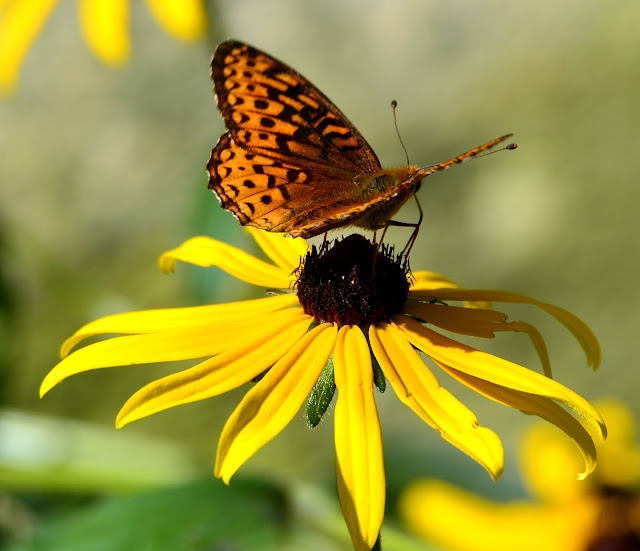When a lawn borders water, it is verboten to nurture it with a vast array of chemicals. Actually, it is never a good idea to bathe one's lawn in biocides, but due to the ongoing plot against the middle class, most feel compelled to do so.
However, if the fate of suicidal, wimpy, and non-native grasses is cast to the seeds in the wind, and the scheduled toil of mowing is ignored, an amazing thing occurs.
Everyone benefits when noxious chemicals are not applied to artificial looking lawns, and precious time is not used to clip one's grasses to less than the length of a finger.
The fish, the turtles, the waterbirds and a host of others thank us.
The Department of Environmental Conservation (DEC) says that not using phosphorus or nitrogen-containing fertilizer minimizes Harmful Algae Blooms (HABs). One step better is no fertilizer at all! Thankfully, no DAPs (Depressingly Accurate Photos) of HABs will be presented here.
And leaving the mower in the garage not only allows the flowers to flourish. Many types of pollinators also benefit.
However, if the fate of suicidal, wimpy, and non-native grasses is cast to the seeds in the wind, and the scheduled toil of mowing is ignored, an amazing thing occurs.
 |
| White Clover flowers appear! |
Everyone benefits when noxious chemicals are not applied to artificial looking lawns, and precious time is not used to clip one's grasses to less than the length of a finger.
The fish, the turtles, the waterbirds and a host of others thank us.
 |
| The wildflowers also thank us. |
 |
| When I asked if the daisies appreciated not being mowed, they gave me their answer true. |
 |
| But there will be photos of lawn residents allowed to bloom! For example, this Meadow Hawkweed, a European immigrant, now naturalized. |
 |
| Some are individualistic. |
 |
| Clover also comes in purple. Of course it was named "red clover" by the same colorblind naturalist who named the purple finch. |
 |
| Even up close, not seeing much red. I suppose it's good not to see red. |
 |
| These are nice little violet-colored flowers. I wonder what they're named. |
 |
| This bug would not tell. |
 |
| Well if it isn't a Philly Fleabane! |
 |
| The petals start out magenta-ish and then turn white. Very pretty! |
 |
| Here's a Devil's Paintbrush. Why would anyone give such a beauty such an awful name? Why not a Kodak Paintbrush? Oh, maybe that's the connection. |
 |
| Fuzzy all the way. |
 |
| A favorite, no matter what the name. |
 |
| A lovely White Admiral. |
 |
| Here neatly balanced on a yet-to-bloom hydrangea. |
 |
| Another bee at work. |
 |
| The bee seems busy. |
 |
| What pollinator is interested in this Wood Anemone? |
 |
| Maybe this Red Admiral, also named by the color-blind naturalist. |
 |
| Happy to move a your pollen for a little nip of nectar. |
 |
| The rear of his or her wings appear shredded, certainly not by the mower. Perhaps an encounter with some bird who swallowed the tail? |
 |
| This Tiger Swallowtail carries on regardless, testing some domesticated nectar. |
 |
| Back to the wildflowers! |
 |
| Aphrodite is happy with the Black-eyed Susan. |
 |
| Delicately testing the eye. |
 |
| How sad that such a beautiful flower was named for the result of an abusive relationship. |
 |
| Blue-tailed Damselflies (different naturalist) also make their appearance, but not as pollinators. They're looking for other nice juicy bugs. |
 |
| And the bees just keep buzzing along. |

I saw lotsa red! - Colorblind Camper.
ReplyDeleteWell that explains it perfectly.
Deletebeautiful photos and a wonder of natural attractions to the right environment! I am a beekeeper and really appreciate the native flowers and what we call weeds, great source of nectar and pollen.
Deleterosemary
Great perspective, Rosemary
DeleteBeautiful, Randy! But I have to ask...is this what you told Mary when she asked you to mow the lawn?
ReplyDeleteYou're way too short to be middle class.
ReplyDeleteDon't be a heightist.
Delete